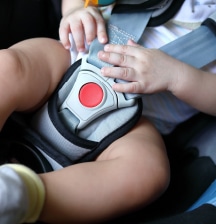
It’s important to teach our children road safety from early on, explains Tiffany Brown.
As adults we may feel terrified at the thought of road accidents and mishaps involving our children, but it’s important we try not to impart any sense of panic around the topic of road safety. This may disturb and distress children and make it more difficult for them to learn safe practices around roads and cars. Always use a calm, reassuring tone of voice; you’re looking for a balance between frightening them and making sure they understand vehicles can be unpredictable, and roads and driveways are not play spaces.
IT STARTS AT HOME
There are some key ways you can teach our children to be safe and respectful around vehicles and roads before you even venture out.
- Children should only play outside in fully fenced areas, away from traffic and driveways.
- Tell them that vehicles and driveways can be dangerous, and we must be very careful around them. “Looking and listening” are important senses to use around roads and cars.
- Once walking independently, children should be taught to wait for an adult before heading to the car.
- If a ball, toy, or pet escapes onto the road during play, make sure your child knows they must get an adult to help. If this isn’t possible, they should wait for the ball to stop rolling, walk so they’re directly opposite the ball, and enact a kerb drill to retrieve it.
TAKING A WALK
Walking together is an ideal situation to teach road safety. You, the adult, are not distracted by operating a car or bike, and you can more easily create a dialogue with your child and ensure important messages and concepts are sinking in. Children under the age of 10 should always hold the hand of a responsible adult.
- Make sure your hands are free, and if necessary, take children out separately, or enlist the help of another adult. If you have a number of children in your care, teach the oldest first, and be confident of their road safety awareness before venturing out in a larger group.
- Crouch down so that you’re eye level with your child. The senses are vital when it comes to road safety, so you need to understand how they hear and see in order to relay appropriate safety instructions to them.
- Use clear, direct statements, such as: “We always look both ways before crossing the road. Listen out for cars, and make sure the road is clear of traffic before we cross.”
- Teach your child to walk on the footpath closer to houses or buildings and away from the road, to look and listen for traffic at driveways, how to deal with blocked driveways, and how to share the footpath with others such as cyclists, scooters, wheelchairs, and mobility scooters.
- If walking on rural roads, teach your child to walk facing the oncoming traffic, keeping as far off the road as possible, and listen carefully ‒ often traffic travelling at high speeds can be heard before it’s seen.
- Check whether your school runs a walking bus, where groups of children walk to school as a group, learning road safety as they go.
HEADING OUT IN THE CAR
Teaching a child to be aware of road safety from inside the vehicle not only helps them learn from a safe distance, it can also be an effective way to distract them from all-too-stressful “car ride boredom”.
Talk through key concepts to very young children as they’re being carried or pushed: “I’m buckling you into your car seat to keep you safe while we drive in the car.”
As you drive, point out road hazards and examples of good road safety, such as supervised crossings around schools, to grow their awareness.
Teach your child to wait until the car has stopped completely before getting in and out. Don’t release seat belt restraints until the vehicle is parked and turned off.
Children should get in and out of the car on the footpath side, and wherever possible you should park on the same side of the road as your destination.
Teach children not to distract the vehicle driver, keep their hands and legs inside the car, check with the driver before opening windows, and to look for cyclists or pedestrians before opening the car door.








